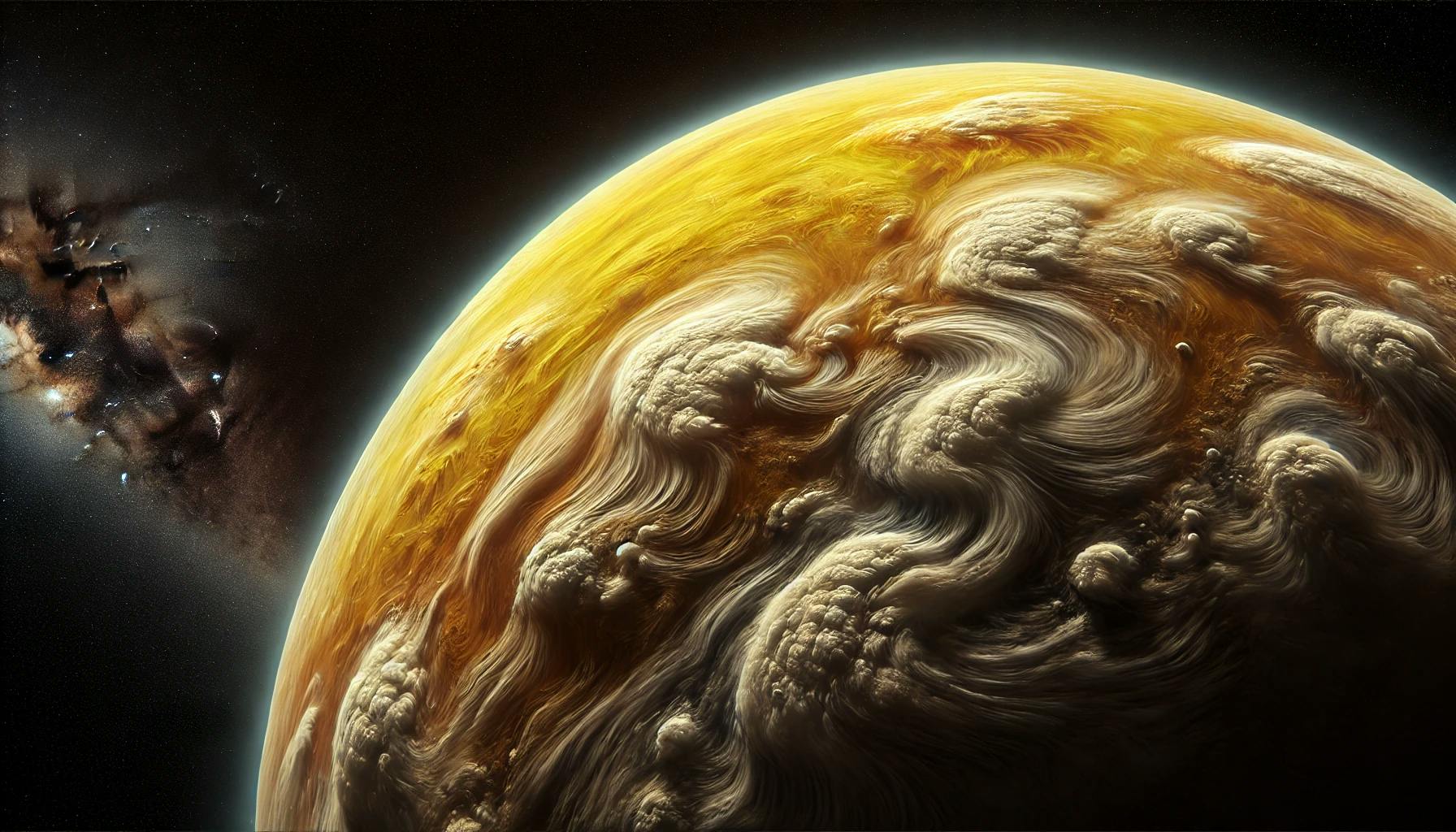Authors:
(1) Sara Seager, Departments of Earth, Atmospheric and Planetary Sciences, Physics, Aeronautics and Astronautics, Massachusetts Institute of Technology, Cambridge, Massachusetts, USA;
(2) Janusz J. Petkowski, Department of Earth;
(3) Peter Gao, Department of Astronomy, University of California at Berkeley, California, USA;
(4) William Bains, Department of Earth;
(5) Noelle C. Bryan, Department of Earth;
(6) Sukrit Ranjan, Department of Earth;
(7) Jane Greaves, School of Physics and Astronomy, Cardiff University, Cardiff, United Kingdom and Institute of Astronomy, Cambridge University, Cambridge, United Kingdom.
Table of Links
Abstract and 1. Introduction and Overview
- Challenges and Assumptions for Life in the Venusian Clouds
- A Proposed Cycle for Venusian Aerial Microbial Life
- Discussion
- Summary, Acknowledgments, Author Disclosure Statement, Funding Information, and References
2. Challenges and Assumptions for Life in the Venusian Clouds
The Venusian cloud decks are often described as a potentially habitable environment. The severe and unique environmental challenges, however, are often insufficiently explored. In this section, we review and emphasize the incredibly harsh conditions in the Venusian temperate clouds and cloud layer—far more extreme than any on Earth. Major assumptions must be made to envision life existing in such harsh conditions. After arguing why life must be confined to the inside cloud droplets, we review the challenges in order of severity.
2.1. Arguments for why microbial life ‘‘outside the droplets’’ is implausible
The requirement for a liquid environment is one of the general attributes of all life regardless of its biochemical makeup. If life’s requirement for a liquid environment is universal, then on Venus the only conceivable stable habitat that meets this criterion is inside of cloud droplets.
Our main argument for why Venus atmosphere life outside liquid droplets is not possible is that free-floating life outside of droplets would rapidly desiccate (by net loss of liquid to the atmosphere) in the very dry atmosphere of Venus. Specifically, a free-floating cell will lose water until its internal water activity is the same as the vapor pressure of the atmosphere around it, which is more than an order of magnitude lower than the driest environments on Earth (Section 2.3). A non-desiccated cell will either have a water activity that is lower than that of the atmosphere around it, in which case water will condense onto it and it will then be in a droplet, or have a water activity that is higher than that of the atmosphere around it, and so will dry out. Only cells in a droplet will be stable. Dried out cells cannot actively divide.* To withstand the dry atmosphere of Venus, microbial life must use the protective environment of the inside of the droplet. In our proposed hypothesis, only one small part of the life cycle has desiccated cells in the form of spores that are dormant.
On Earth, free-floating metabolically active cells outside of cloud water droplets are known to exist, but they are a small fraction of the overall aerial biomass. Free-floating cells are, however in danger of severe desiccation and death, if not deposited back on the surface within a few days. In addition, if such free-floating cells are swept up into the stratosphere, where the stellar UVC becomes the main sterilizing factor, they also die in a matter of days (Bryan et al., 2019).
Published papers do not discuss the exact habitat for the hypothesized life in the Venusian clouds. One paper does link particles in the lower Venusian atmosphere (called Mode 3) to microbial life but only implicitly implies that life resides inside the Mode 3 droplets (Schulze-Makuch et al., 2004). They specifically propose that the Mode 3 particles are microbes that are coated by elemental sulfur (S8 or octathiocane). However, there is an inconsistency here whereby the hydrophobic nature of such pure octathiocane layers with no hydrophilic component would have prevented an efficient accumulation of liquid (both water or sulfuric acid) around the microbial cell, effectively exposing it to the outside atmosphere (Petrova, 2018). We note that if the shell is composed of both elemental sulfur and additional hydrophilic filaments, then active accumulation of liquids could, in principle, be possible.
2.2. The high concentrated sulfuric acid environment
The very high concentration of H2SO4 and extreme acidity is a unique challenge for life on Venus. Prior speculations about life on Venus often emphasize that terrestrial polyextremophiles can tolerate very low pH, high temperature, and low water activity environments with a ‘‘high concentration’’ of sulfuric acid. The implication is that the Venusian sulfuric acid cloud conditions have similarly low water activity and low pH, and hence are conducive to life (Morowitz and Sagan, 1967; Grinspoon, 1997; Cockell, 1999; Schulze-Makuch and Irwin, 2002, 2006; SchulzeMakuch et al., 2004; Grinspoon and Bullock, 2007; Limaye et al., 2018).
This is an incorrect implication. We cannot emphasize enough that the Venusian sulfuric acid clouds are much more acidic than even the most harshly acidic conditions found on Earth—the Dallol Geothermal Area, within the Danakil Depression in Northern Afar (Ethiopia) (Cavalazzi et al., 2019). The Dallol acidic pools are high temperature (108C), hypersaline (NaCl supersaturated), and anoxic hydrothermal sites containing up to 150 g/L of iron with the lowest environmental pH recorded to date (pH between -1.7 and 0) (Kotopoulou et al., 2019).
Preliminary studies suggest that even in such harsh polyextreme hydrothermal conditions, life can survive and possibly even thrive; there are examples suggesting that the Dallol acidic pools are inhabited by very small (*0.2 mm cell size) Nanohaloarchaea and other phyla of archaea (Belilla et al., 2019; Go´mez et al., 2019). (Note that there is one Dallol pool where life has not yet been detected; instead of NaCl, the salts are composed of Mg2+ and Ca2+ ions.) The Dallol acidic pools, however, are not a model for Venusian clouds. The hyper-acidic environment of Dallol pools has water with sulfuric acid dissolved in them; they have the properties of water, even though they have a pH <0. In other words, the Dallol pools correspond to ‘‘only’’ *5% solution of H2SO4. By contrast, the Venusian cloud droplets are sulfuric acid with water dissolved in them.
There is no Earth-based analogy of life adapting to or living in sulfuric acid concentrations as high as those in Venus cloud droplets. It is quite impossible for terrestrial metabolism to function in concentrated sulfuric acid where the majority of terrestrial biochemicals would be destroyed in seconds. There is extensive literature on the reactions of classes of molecules with concentrated sulfuric acid. Crucial biochemicals are unstable in sulfuric acid and include sugars (including nucleic acids, RNA, and DNA) (Krieble, 1935; Dische, 1949; Long and Paul, 1957), proteins (Reitz et al., 1946; Habeeb, 1961), and other compounds such as lipids and complex carbohydrates (as shown, e.g., by studies on dissolution of organic matter away from the outer shell of pollen grains; Moore et al., 1991) and small-molecule metabolites of Earth’s life core metabolism (Wiig, 1930; DeRight, 1934).
One might suggest that Venusian life is insulated from the sulfuric acid environment by elemental sulfur shells (Schulze-Makuch et al., 2004). Elemental sulfur is present in the clouds of Venus (Taylor et al., 2018). More importantly, elemental sulfur is not wetted by sulfuric acid (Petrova, 2018), so in principle it could provide chemical protection from the concentrated sulfuric acid environment. Cells coated with elemental sulfur shells would only adhere to the H2SO4 droplets rather than be entirely enveloped by them. By definition, hydrophobic particles cannot efficiently act as cloud condensation nuclei (CCN)—and thus this concept of protective sulfur shells is incompatible with our proposed life cycle, where the spores must act as CCN to become hydrated.
2.3. Very low water content
If Venusian life is water based, then the extremely dry Venusian atmosphere is a major challenge for life. Global water vapor mixing ratios in the Venusian atmosphere average around 40–200 ppm (Donahue and Hodges Jr, 1992; Barstow et al., 2012). For context, the Venusian atmosphere’s water content would be equivalent to a relative humidity of *0.07% at 298 K (Gmitro and Vermeulen, 1964); the driest air on Earth (excluding artificial laboratory conditions), the Atacama Desert at midday in summer, has a relative humidity of *2% (Ca´ceres et al., 2007), so the environment of Venusian cloud droplets is literally *50 times as arid as the driest place on Earth.
2.4. Nutrient scarcity
Permanently confined to an aerial biosphere, life must get all its nutrients from the atmosphere. We first review and comment on the availability of carbon, hydrogen, nitrogen, oxygen, phosphorus and sulfur (CHNOPS) biogenic elements before turning to the main nutrient scarcity, metals.
CHNOPS elements are all present in the Venusian atmosphere habitable layer as, for example, CO2, N2, SO2, and H2O, in modest amounts. Even phosphorus compounds are measured to be present in the Venusian atmosphere. The abundance of phosphorus in the Venus atmosphere and on the surface has only been measured by one of the Venera descent landers (although this X-ray-based detection determined the elemental P abundance it did not determine which P-bearing chemical species the phosphorus was in). In the altitude range of 52 and 47 km, the abundance of phosphorus appears to be on the same order as the abundance of sulfur (Vinogradov et al., 1970; Surkov et al., 1974; Andreichikov, 1987, 1998), as reviewed in Titov et al. (2018). Above 52 km no phosphorus was detected, and at 47 km the probe appeared to fail. Surface X-ray fluorescence of phosphorus species would have been masked by the much more common silicate.
There are examples on Earth of microbes that obtain all their C and N from the atmosphere. The chemolithoautotrophic and acidophilic bacterium Acidithiobacillus ferrooxidans can fix both CO2 and N2 from the atmosphere to build biomass (Valde´s et al., 2008; Quatrini and Johnson, 2019). A. ferrooxidans lives in extreme environments on Earth at low pH (1–2) and at moderately high temperatures of 50–60C. Life in the Venusian aerial biosphere could use similar autotrophic strategies to that of A. ferrooxidans to obtain nutrients directly from atmospheric gases.
Venus is heavily depleted in hydrogen with respect to Earth. This is illustrated by the increased ratio of deuterium to hydrogen in the Venusian atmosphere. The ratio is *100 times higher as compared with the rest of the solar system planets (Donahue et al., 1982), which likely resulted from a catastrophic loss of water through atmospheric erosion by the solar wind. For comparison, on Earth H2 reaches 0.55 ppm levels (Novelli et al., 1999) whereas on Venus the amount of H2 is much lower at 4 ppb (Krasnopolsky, 2010; Gruchola et al., 2019). Such low abundance of hydrogen could result in hydrogen being a limiting nutrient for any aerial life that resides in the clouds of Venus. Production of hydrogen-rich, biochemically critical molecules, such as CH4 or NH3, might be very much more costly on Venus than on Earth due to the overall hydrogen scarcity.
Metals are scarce in the Venusian atmosphere, and the low metal abundance is likely to be a major growth-limiting factor. Metal ions are required for many biological functions (e.g., more than a third of all proteins in terrestrial eukaryotes and bacteria require metal binding to function properly; Shi and Chance, 2011). Further, previous studies have speculated that Venusian life might use Fe/S redox chemistry as part of the biomass buildup and energy metabolism (Limaye et al., 2018). It is conceivable that there are some amounts of mineral dust from the surface in the atmosphere of Venus and that a fraction of that dust could dissolve in sulfuric acid droplets, thus being accessible for life that resides inside the droplets.
Many metals are soluble in H2SO4, including many silicate ores and other metal salts (although glass and silica species are not). There is extensive literature dating many decades back about the study of metal salts in concentrated sulfuric acid, reviewed in part in Liler (2012). It may be worth acknowledging that although Earth-like biochemistry requires metals for biochemistry this may not be a universal requirement for all life. In principle, many biochemical functions of metals can be substituted by other specialized molecules built exclusively from biogenic CHNOPS elements (Hoehler et al., 2020).
The scarcity of non-volatile nutrients, including metals, could, in principle, be mitigated by meteoritic delivery. The degree to which meteoritic delivery might be efficient is unknown. Although Venus is volcanically active, the planet lacks the global tectonic activity seen on Earth (i.e., plate tectonics) (Byrne et al., 2018). Only a few active volcanic sites have been detected on Venus’ surface (Shalygin et al., 2015; Treiman, 2017) and it is postulated that the overall volcanic flux is much lower than that on Earth (Mikhail and Heap, 2017). It is unknown whether the transport of dust from volcanic activity to the atmosphere is sufficient to be considered a viable source of non-volatile elements for the aerial biosphere in the clouds.
Life on Earth can inhabit environments where nutrients are extremely scarce. A recent example is the discovery of microbial ecologies in the lower oceanic crust (Li et al., 2020). In such a nutrient-scarce environment, the key to life’s survival includes: storage of materials as a source of elements in an event of extreme shortages; recycling and reusing of already acquired nutrients; and metabolic flexibility (i.e., the ability to utilize multiple sources of carbon, nitrogen, energy, etc.). Similarly, life in Earth’s aerial biosphere has developed a series of specific adaptations for efficient capture of limiting nutrients, including siderophoremediated transition metal capture (see ahead to Fig. 4) (Amato et al., 2019). It is conceivable that Venusian life, if it exists, has evolved similar solutions. If such solutions allowed for the efficient scavenging and recycling of metallic trace elements by Venusian life, then surface dust, meteoritic influx, or both could provide a sufficient source to compensate for losses.
2.5. Energy requirements and the assumption of photosynthesis
Living in the nutrient-depleted incredibly harsh conditions of the Venusian cloud decks—much more extreme than any conditions found on Earth—is likely incredibly energy intensive. For example, significant energy would be expended on such cellular processes as: active transport of substances through the cell membrane against the concentration gradient (e.g., active import of water, if life on Venus is water based [see the example below]); acquisition of gaseous nutrients and fixation of elements into organic matter (e.g., nitrogen fixation); biosynthesis of complex biochemicals that are crucial for nutrient storage, recycling, and retention (e.g., siderophores for metal reuse and retention [see Section 2.4 above]); and, finally, motility if the microorganism needs to actively move within a droplet (e.g., ciliary or flagellar movement).
We must assume that Venusian aerial microbial life is photosynthetic, so that energy capture is not a limiting factor. First, this is because there is little chemical energy potential within the atmosphere, and any redox disequilibria on the surface (the type of disequilibria exploited by terrestrial chemotrophs) are inaccessible to cloud-based life. Second, it is because of the abundance of solar energy on Venus and noting that the conversion of light energy to chemical energy through photosynthesis is the fundamental process in which life on Earth harnesses energy (the other being redox reactions). In fact, it has been speculated that the ‘‘unknown UV absorber’’ in the clouds of Venus, a chemical species of unknown identity, absorbing more than half of all UV that the planet receives could be a manifestation of a wide-spread energy-capture process by an aerial biosphere (Limaye et al., 2018).
Photosynthesis need not be oxygenic, or even for carbon fixation. Life on Earth uses several strategies to photosynthetically fix carbon, with oxygenic photosynthesis being only one of the possibilities (reviewed in Seager et al., 2012). Examples of anoxygenic photosynthesis include several types of sulfur-based photosynthesis, for example, used by green sulfur bacteria, or more exotic arsenic photosynthesis employed by Ectothiorhodospira bacterial communities from hot springs in Mono lake, California (Kulp et al., 2008; Hoeft McCann et al., 2017). Sulfur-based photosynthetic strategy was proposed as a potential means in which Venusian life could fix carbon (Schulze-Makuch et al., 2004). We emphasize, however, that the use of light energy by life to run chemical reactions, generate and store energy is not limited to carbon fixation.
There are a number of terrestrial examples for utilization of sunlight for metabolic processes other than fixing carbon. (In principle, any chemical reaction or metabolic activity can be coupled to the light-capturing process.) Aphids, for example, have a layer of carotenoids under the cuticle that forms a sunlight-harvesting system coupled to the synthesis of adenosine triphosphate (ATP) (Valmalette et al., 2012). Carotenoid pigments capture light energy and pass it on to the cellular machinery involved in energy production, a process completely independent from ‘‘classical’’ carbon fixation done in photosynthesis.
UV radiation should not be a problem for any assumed Venusian life because of UV-protecting pigments, such as melanins. It is possible that melanins can harness highenergy electromagnetic radiation (a phenomenon called radiosynthesis) for useful metabolic activity. Some species of fungi (e.g., Cryptococcus neoformans) can use this harsh ionizing radiation to promote growth (Dadachova et al., 2007; Dighton et al., 2008). The discovery of organisms that actively seek sources of highly ionizing radiation (they are radiotrophic) and preferentially grow in such environments (they were detected in space stations, Antarctic mountains, and in the nuclear reactor cooling water) opens the possibility that fungal melanins could have functions analogous to other energy harvesting pigments such as chlorophylls in algae and plants (Dadachova and Casadevall, 2008). So rather than solar UV being a problem for life at the top of the clouds, it could be a resource to be used. We note that the flux of ionizing radiation (galactic cosmic rays or extreme solar particle events) is only sterilizing high up in the atmosphere, and thus it is not a significant survival challenge for our putative Venusian aerial biosphere in the temperature cloud region (Dartnell et al., 2015).













